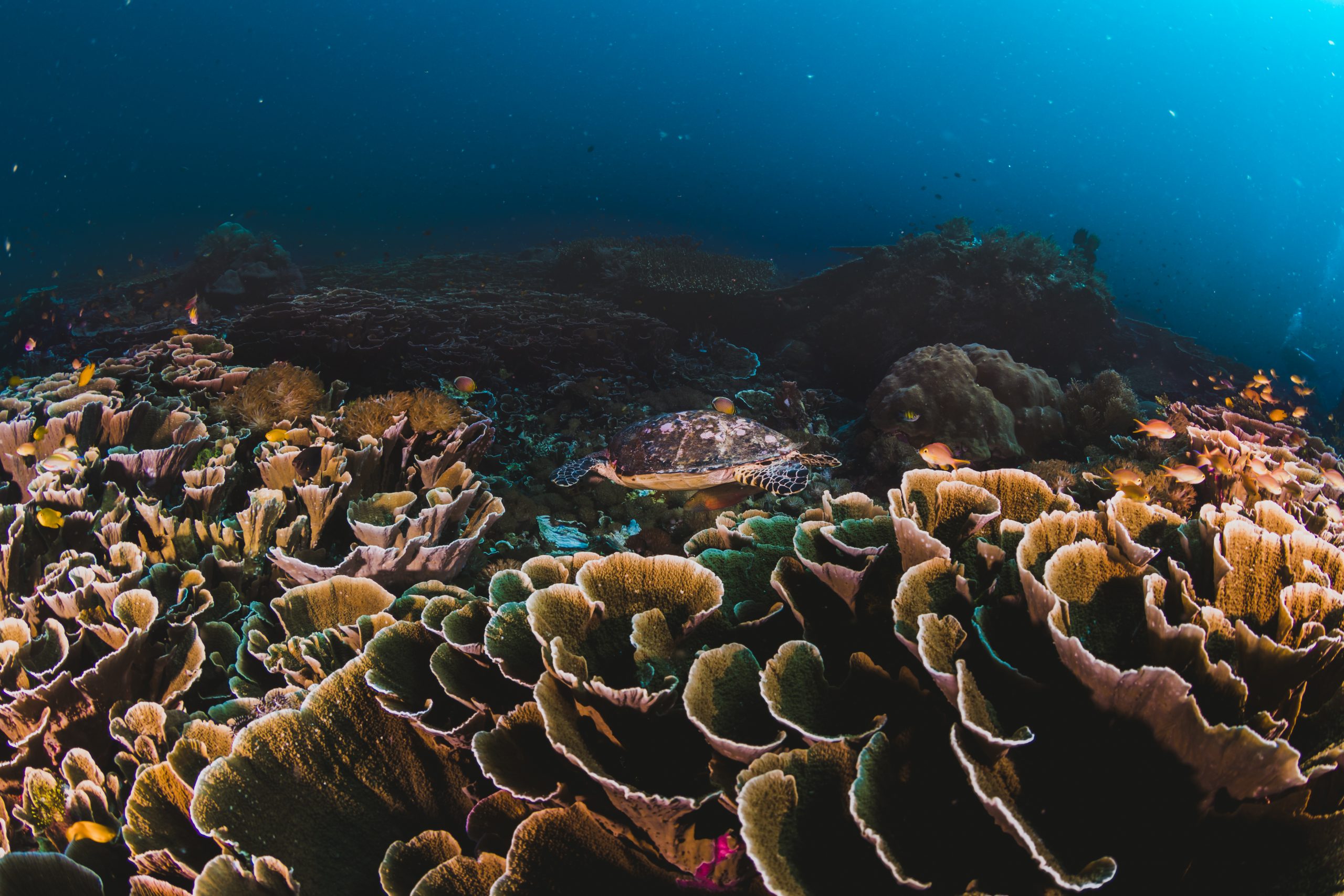Sustainability is not an option for tourism, it is core business. The Queensland Tourism Industry Council (QTIC) has 1,000 direct members and about 3,000 affiliate regional members. They include large and small tourism operators, training organisations, universities, consultants, industry suppliers and even local councils. Our members operate in a state with some of Australia’s most iconic natural assets. As a result, advocating for and practicing sustainability has been a priority for decades. Our industry’s commercial future depends on it. As global environmental pressures increase, our industry can help demonstrate that a simultaneously prosperous and sustainable future is possible.
Tourism is defined in various ways, but at its core it is ‘the act and process of spending time away from home’[1]. Or, to put it differently, it is the act of looking at the world from a different perspective. A different perspective is what we need to achieve the ambitious vision of a sustainable coastal and marine sector. The people engaged in tourism, both consumers and providers, are exceptionally well placed to become agents for positive change and to make tourism an effective driver towards the goals embedded in that vision.
By its very nature, tourism activity sits at the intersection of economic, social and environmental spheres, dependent on each and having an impact on all. Although often measured in purely economic or commercial terms, tourism is co-dependent on community, culture, and natural assets, including marine environments and the ocean, to create marketable experiences. Rather than deriving profits through an ‘extractive’ process, commercial tourism has a material interest in socially and environmentally sustainable practices as a way of ‘doing business’.
Visitors, for their part, being ‘away from home’ and benefitting from a different perspective, tend to have a higher awareness of their social and environmental surroundings. As Sinead Mulhern puts it, ‘Moments of being immersed in a totally different culture play a key role in allowing travelers to develop a more open mind.’[2]
Operators’ commercial self-interest and visitors’ potential open-mindedness offer us an opportunity to promote and drive the three key shifts needed to achieve sustainable coastal and marine tourism in 2030 and 2050:
- A more comprehensive way of valuing our environmental and social assets alongside economic measures.
- A better understanding and assignment of responsibilities across private and public sectors and between collective and individual roles.
- A greater sense of urgency to achieving change.
On the first shift, perhaps no example is more instructive than the Great Barrier Reef (GBR), which stretches about 2,500 kilometres along the coast of Queensland. Less than 60 years ago the GBR was slated to have ‘lumps of coral’ mined as cheap limestone fertiliser for a local farmer, and most of what is now the UN World Heritage–listed GBR Marine Park had oil exploration leases allocated by the government[3]. Only the timely and determined intervention of a few individuals who perceived the intrinsic value of the GBR ecosystem prevented disaster and allowed the GBR to evolve into Australia’s major natural tourism drawcard, valued at $56 billion, generating more than $6.4 billion in annual revenue and sustaining 64,000 jobs.
The process of understanding and protecting the GBR ecosystem and its relationship with the coastal community and economy continues to this day. Along the journey, the partnership between the tourism industry, researchers, the community and the management agencies has helped develop a deeper appreciation of the reef’s value as a natural resource and an economic asset. In 2004 the QTIC and the Worldwide Fund for Nature (WWF) published the first report on threats global warming poses to both the GBR ecosystem and the coastal economy that depends on it[4]. The report used the latest Intergovernmental Panel on Climate Change scenarios to estimate the potential losses in the GBR’s value. In 2018 a report commissioned by QTIC and WWF applied an economic methodology to estimate the investment needed to retain the GBR’s economic and environmental value[5].
Bringing an economic, tourism-use and community perspective to challenges of marine park management has supported significant changes in policy and management. Awareness of how prosperity can be enhanced through environmentally sustainable practices can make communities and industries fierce advocates for change. Without the tourism industry’s outspoken support, it is unlikely the highly successful Representative Areas Program would have been implemented as designed despite compelling scientific evidence[6]. The industry’s support was gained both by strong, evidence-based advocacy from individual ‘champions’ and thought leaders and through patient engagement with relevant stakeholders and community groups. Trust cannot be substituted in the process of building broad-based support for change. Communities and industries that develop a practical, place-based understanding of how the ocean’s environmental services can deliver triple bottom-line benefits will take us closer to our goals.
The second, necessary shift is an extension of the first. Complex, large-scale environmental assets like the ocean, with particular property-right circumstances, pose an enormous challenge in co-ordinating effective actions. On the one hand, local communities need to accommodate diverse economic priorities that may negatively impact on the ocean, including fishing and coastal development. On the other hand, large-scale challenges, like water quality and plastics pollution, require comprehensive, global measures. At both ends of the scale, agencies and individuals need to understand their roles and their responsibilities in bringing about change. We need to encourage individuals and agencies to ask themselves how they fit into the global ecosystem.
Two things can be done to prompt this reflection. Firstly, applied research, combining scientific expertise with practitioners from industry, resource managers and, secondly, First Nations People, can help us better understand the interdependency of actions and the impacts of ocean use and management practices. This motivation prompted the tourism industry to collaborate with scientists and other stakeholders to create the Reef and Rainforest Research Centre in Cairns in 2006, with one objective being creation of ‘a unique engagement framework in which researchers and end users collaboratively define and implement solution-focused science’[7]. Financially supported under subsequent Commonwealth environmental programs, this initiative has delivered numerous research projects with practical applications for industry, the community and resource managers, including the Great Barrier Reef Marine Park Authority (GBRMPA). Collaborative research such as this can provide the evidence, accessible to a broader audience, to engage relevant parties and allocate local and global responsibilities. As the UN World Heritage Committee recognised in its 2012 Mission Report on the GBR, the collaborative generation of scientific knowledge can itself drive a greater sense of individual responsibly and actions: ‘Plans and permitting arrangements targeting commercial marine tourism have been systematically implemented and an array of policies, position statements and guidelines has been developed and are communicated in a clear and transparent manner to the public. As a result of this concerted action, and primarily through the establishment of industry partnerships, commercial marine tourism is now planned and managed sustainably, with minimal environmental and social impacts such as crowding’[8].
Active engagement of all parties in research and data gathering, including through ‘citizen science’ programs, has also been very successfully applied in the GBRMPA’s Reef Guardian Schools program, which ‘empowers students and gives them a sense of involvement in the bigger picture and encourages them to make a positive difference’[9]. A differently targeted Reef Guardian Councils program ‘recognises [that] the effective management and protection of the Reef requires a coordinated effort from industries, communities and all levels of government’[10]. A growing number of local governments along the coastline, currently 19 with a combined population of approximately 1 million residents, are undertaking practical projects to ‘protect and conserve the Marine Park through activities that improve the health and resilience of the Reef’[11]. Similarly, the highly successful Eye on the Reef ‘monitoring and assessment program enables anyone who visits the Great Barrier Reef to contribute to its long-term protection by collecting valuable information about reef health, marine animals and incidents that is used to understand the bigger picture and inform how we manage the Reef’[12]. The latter program is specifically aimed at visitors, who gain a much deeper understanding of ecological processes and the driving factors of change. As the UNESCO Mission Report noted, ‘The increased provision of visitor facilities to support sustainable tourism and enhance the appreciation of the property in itself is also an important contributor to the realisation of aesthetic values’[13]. This assessment was confirmed by more recent research, which found that ‘77 per cent of people felt the Great Barrier Reef was part of their identity as Australians and 43 per cent of people listed it as the most inspiring Australian icon, more than five times the level of Uluru, the second most inspiring icon’[14]. An informed ‘line of sight’ to ocean ecologies and any active engagement is the most likely path towards individual behavioural change and will also help frame public opinion and policy direction. The GBR Marine Park would not enjoy its level of protection and government funding if not for the strong public appreciation of its value.
The third key shift must be a far greater sense of urgency that our planet’s ocean is under threat and needs both local and global action. The greater understanding and engagement advocated under the first two shifts will make it easier to demonstrate negative trends resulting from overuse, pollution or global warming. It will also be easier to identify remedial actions and implement change for industry and resource managers. Equally important, a better-informed local community can shape and promote necessary policy change at the local, national and global levels.
Making location-relevant data and research findings accessible to a broader audience in a timely manner is critical to turning communities and industry into active stakeholders. Science communication, through trusted sources, including industry organisations, should never be an afterthought but must be integrated into any applied research from project conception. Knowledge is a more powerful driver for action on sustainability than compulsion. At QTIC we have further found that change is best promoted through ‘peer-to-peer’ delivery. Successful businesses that are ‘ahead of the curve’ are far more likely than external agencies to get the attention of other operators regarding the need for and benefit of new practices. Peer-to-peer support can occur through working groups, committees, networking events and on-line discussion groups. The latter was particularly relevant for our members during the COVID pandemic.
We are all part of the ocean’s ecology and we all depend on its sustainable future. The more we can inform and engage individuals, communities and policymakers, the more likely we will be to achieve the goals articulated by the High Level Panel for a Sustainable Ocean Economy.
—–
[1] Encyclopaedia Britannica, “Tourism,” https://www.britannica.com/topic/tourism.
[2] S. Mulhern, “How Traveling Makes You More Open-Minded,” WorldPackers, 19 June 2019, https://www.worldpackers.com/articles/how-traveling-makes-you-more-open-minded.
[3] I. McCalman, The Reef: A Passionate History (New York: Viking, 2013), 266.
[4] WWF Great Barrier Reef 2050: The Implications of Climate Change for Australia’s Great Barrier Reef, February 2004.
[5] Queensland Farmers Federation, Queensland Tourism Industry Council, WWF, and Association of Marine Park Tourism Operators, Investing in the Great Barrier Reef as Economic Infrastructure, 2016.
[6] L. Fernandes et al., “Establishing Representative No-Take Areas in the Great Barrier Reef: Large-Scale Implementation of Theory on Marine Protected Areas,” Conservation Biology 19, no. 6 (2005): 1733–44; J. Day, L. Fernandes, A. Lewis, G. De’ath, S. Slegers, B. Barnett, B. Kerrigan et al., “The Representative Areas Program for Protecting Biodiversity in the Great Barrier Reef World Heritage Area,” in Proceedings 9th International Coral Reef Symposium, Bali, Indonesia, 23–27 October 2000.
[7] Reef and Rainforest Research Centre, “Our Services,” https://www.rrrc.org.au/our-services/.
[8] UNESCO Mission Report , Reactive Monitoring Mission to Great Barrier Reef
(Australia), 6th to 14th March 2012, 24.
[9] Great Barrier Reef Marine Park Authority (GBRMPA), “Reef Guardian Schools,” https://www.gbrmpa.gov.au/our-work/our-programs-and-projects/reef-guardians/reef-guardian-schools.
[10] GBRMPA, “Reef Guardian Councils,” https://www.gbrmpa.gov.au/our-partners/reef-guardian-councils.
[11] GBRMPA, “Reef Guardian Councils.”
[12] GBRMPA, “Eye on the Reef,” https://www.gbrmpa.gov.au/our-work/eye-on-the-reef.
[13] UNESCO Mission Report GBR (N154) 2012, 17.
[14] J. Goldberg, N. Marshall, A. Birtles et al., “Climate Change, the Great Barrier Reef and the Response of Australians,” Palgrave Communications 2 (2016): 15046.






